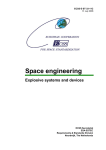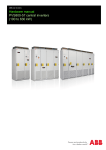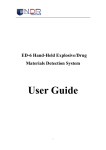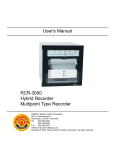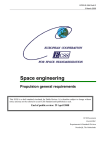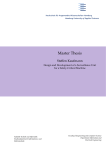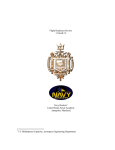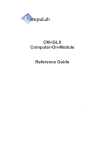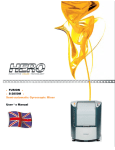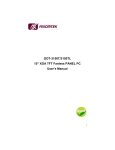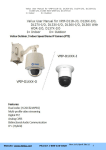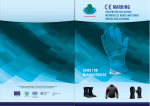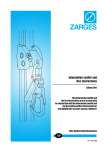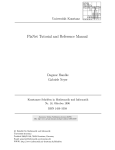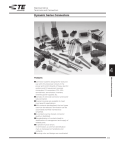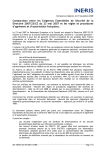Download Space engineering
Transcript
ECSS-E-33-11A Draft 4 21 Sept 2007 Space engineering Explosive systems and devices This ECSS document is a draft document distributed for Public Review. It is therefore subject to change without any notice and my not be referred to as en ECSS Standard until published as such. End of Public Review: 20 November 2007 ECSS Secretariat ESA-ESTEC Requirements & Standards Division Noordwijk, The Netherlands ECSS-E-33-11A Draft 4 21 Sept 2007 Published by: ESA Requirements and Standards Division ESTEC, P.O. Box 299, 2200 AG Noordwijk, The Netherlands ISSN: 1028-396X Price: 20 Euro Printed in: The Netherlands Copyright: © 2007 ECSS by the European Space Agency for the members of ECSS 2 ECSS-E-33-11A Draft 4 21 Sept 2007 Foreword This Standard is one of the series of ECSS Standards intended to be applied together for the management, engineering and product assurance in space projects and applications. ECSS is a cooperative effort of the European Space Agency, national space agencies and European industry associations for the purpose of developing and maintaining common standards. Requirements in this Standard are defined in terms of what shall be accomplished, rather than in terms of how to organize and perform the necessary work. This allows existing organizational structures and methods to be applied where they are effective, and for the structures and methods to evolve as necessary without rewriting the standards. The formulation of this Standard takes into account the existing ISO 9000 family of documents. This Standard has been prepared by the ECSS-E-33-11 Working Group, reviewed by the ECSS Executive Secretariat and approved by the ECSS Technical Authority. 3 ECSS-E-33-11A Draft 4 21 Sept 2007 (This page is intentionally left blank) 4 ECSS-E-33-11A Draft 4 21 Sept 2007 Contents Foreword...................................................................................................................................................3 1 Scope ...............................................................................................................................................7 2 Normative references .......................................................................................................................9 3 Terms, definitions and abbreviated terms ......................................................................................11 3.1 Terms and definitions ....................................................................................................................... 11 3.2 Abbreviated terms ........................................................................................................................... 15 3.3 Symbols............................................................................................................................................ 15 4 Requirements .................................................................................................................................17 4.1 General............................................................................................................................................ 17 4.2 Design .............................................................................................................................................. 18 4.3 Mission.............................................................................................................................................. 19 4.4 Functionality ..................................................................................................................................... 20 4.5 Safety ............................................................................................................................................... 20 4.6 Survival and operational conditions ................................................................................................. 21 4.7 Interface requirements..................................................................................................................... 22 4.8 Mechanical , electrical, and thermal requirements......................................................................... 23 4.9 Materials........................................................................................................................................... 27 4.10 Non-explosive components and equipment ................................................................................... 28 4.11 Explosive components ..................................................................................................................... 33 4.12 Explosively actuated devices ........................................................................................................... 46 4.13 Items external to the flight equipment ............................................................................................. 51 4.14 Verification ....................................................................................................................................... 51 4.15 Transport, facilities, handling and storage........................................................................................ 56 4.16 In-service.......................................................................................................................................... 57 4.17 Product assurance ........................................................................................................................... 58 4.18 Deliverables ..................................................................................................................................... 58 Annex A (normative) Explosive sizing methodology ................................................................................61 Annex B (normative) Explosive component colour code.........................................................................63 Annex C (informative) Qualification test levels........................................................................................65 Tables Table 1 Common requirements for initiator, cartridge, detonator, and packaged charge properties........ 34 Table 2 Requirements for low voltage initiator properties ............................................................................. 35 Table 3 Requirements for high voltage initiator properties ........................................................................... 36 5 ECSS-E-33-11A Draft 4 21 Sept 2007 Table 4 Requirements for laser initiator properties ........................................................................................ 37 Table 5 Requirements for mechanical initiator properties............................................................................ 37 Table 6 Requirements for packaged charge properties.............................................................................. 38 Table 7 General requirements for transfer device properties ....................................................................... 39 Table 8 Requirements for shielded transfer line properties ........................................................................... 39 Table 9 Requirements for through-bulkhead transfer device properties....................................................... 41 Table 10 Requirements for shaped charge properties................................................................................. 42 Table 11 Requirements for expanding tube device properties .................................................................... 43 Table 12 Requirements for distribution box properties.................................................................................. 44 Table 13 Requirements for explosive delay properties ................................................................................. 45 Table 14 Common requirements for gas generator .................................................................................... 46 Table 15 General requirements for explosively actuated device properties ................................................ 47 Table 16 Requirements for separation nut and separation bolt properties .................................................. 48 Table 17 Requirements for puller properties................................................................................................. 49 Table 18 Requirements for pusher properties............................................................................................... 49 Table 19 Requirements for cutter properties ................................................................................................ 50 Table 20 Requirements for valve properties ................................................................................................. 50 Table 21 Safety tests .................................................................................................................................... 53 Table 22 Reliability methods ........................................................................................................................ 53 Table 23 Qualification tests .......................................................................................................................... 54 Table 24 Acceptance tests.......................................................................................................................... 55 Table 25 Main project documents and the corresponding DRD ................................................................. 59 Table 26 Other technical documents and the corresponding DRD (non-exhaustive list) ............................. 59 Table C- 1 Qualification test levels............................................................................................................... 65 Table C- 2 Pyroshocks for launcher and satellites ........................................................................................ 66 6 ECSS-E-33-11A Draft 4 21 Sept 2007 1 Scope This part defines the standards to be applied for the use of explosives on all spacecraft and other space products including launch vehicles. It addresses the aspects of design, analysis, verification, manufacturing, operations and safety. As any explosive item used for flight can function only once, it can never be fully tested before its crucial mission operation. The required confidence can only be established indirectly by the testing of identical items. Test results and theoretical justification are essential for demonstration of fulfilment of the requirements. The requirement for repeatability shows that product assurance plays a crucial role in support of technical aspects. The need for statistics requires that the explosive components used in the explosive system be tested and characterized extensively. The variability in components requires that manufacturers prove to customers that delivered items are identical to those qualified. The failure or unintentional operation of a explosive item can be catastrophic for the whole mission and life threatening. Specific requirements can exist for the items associated with it. As all explosives where ever used are to be treated similarly, the same requirements, regulations, practices and standards need to be applied which will help to avoid human error. In case there is sufficient data to establish the reliability and confidence level for any given performance against any given condition, this should be done. Subsequently all margins should be converted into standard deviations and be incorporated into the reliability and confidence analysis. When viewed from the perspective of a specific project context, the requirements defined in this Standard should be tailored to match the genuine requirements of a particular profile and circumstances of a project. NOTE Tailoring is a process by which individual requirements of specifications, standards and related documents are evaluated, and made applicable to a specific project by selection, and in some exceptional cases, modification of existing or addition of new requirements. 7 ECSS-E-33-11A Draft 4 21 Sept 2007 (This page is intentionally left blank) 8 ECSS-E-33-11A Draft 4 21 Sept 2007 2 Normative references The following normative documents contain provisions which, through reference in this text, constitute provisions of this ECSS Standard. For dated references, subsequent amendments to, or revisions of any of these publications do not apply. However, parties to agreements based on this ECSS Standard are encouraged to investigate the possibility of applying the most recent editions of the normative documents indicated below. For undated references the latest edition of the publication referred to applies. ECSS-E-10-02A Space engineering — Verification ECSS-E-10-03 Space engineering — Testing ECSS-E-20A Space engineering — Electrical and electronic ECSS-E-20-07 Space engineering — Electromagnetic compatibility ECSS-E-20-06 Space engineering — Spacecraft charging ECSS-E-30 Part 2A Space engineering — Mechanical — Part 2: Structural ECSS-E-30-10A Space engineering — Reliability based mechanical factors of safety ECSS-E-33-01 Space engineering— Mechanism ECSS-E-30 Part 8A Space engineering — Materials ECSS-E-40 Space engineering — Software ECSS-Q-20 Space product assurance — Quality assurance ECSS-Q-30 Space product assurance — Dependability ECSS-Q-40 Space systems — Safety ECSS-Q-70B Space product assurance — Material, mechanical parts and processes ECSS Q-70-71A Data for selection of space materials and processes ECSS Q-70-26A Space product assurance — Crimping of high-reliability electrical connections MIL-STD-1576 Issue 31/7/84 Electro-explosive Sub-system Safety Requirements. ST/SG/AC 10/1 Rev. 14 or xx United Nations Organization Transport of Dangerous Goods. 9 ECSS-E-33-11A Draft 4 21 Sept 2007 ISO 16269-6 Statistical interpretation of data — Part 6: Determination of a statistical tolerance interval. First edition 2005-04-01 CSG-RS-22A-CN + PM RS 2002/57 10 CSG Safety Regulations ECSS-E-33-11A Draft 4 21 Sept 2007 3 Terms, definitions and abbreviated terms 3.1 Terms and definitions The following terms and definitions are specific to this standard in the sense that they are complementary or additional to those contained in ECSS-P-001. 3.1.1 all fire stimulus with a probability of functioning equal to or better than 0,999 at 95% confidence level 3.1.2 armed condition that allows the probability of a wanted event to be above an agreed limit 3.1.3 cartridge explosive device designed to produce pressure for performing a mechanical function NOTE A cartridge is called an initiator if it is the first or only explosive element in an explosive chain. 3.1.4 catastrophic failure failure resulting in loss of life or life-threatening or permanently disabling injury or occupational illness or loss of an element of an interfacing manned flight system or loss of mission or loss of launch site facilities or long term detrimental environmental effects NOTE For payloads of the NASA STS or ISS, the applicable definition is: failure that results in personnel injury, loss of the NASA orbiter, ground facilities, or STS equipment (see NSTS 1700.7, paragraph 302). 11 ECSS-E-33-11A Draft 4 21 Sept 2007 3.1.5 charge quantity of explosive loaded in a cartridge, detonator, or separate container for use in a explosive device 3.1.6 component smallest functional item in a explosive subsystem 3.1.7 deflagration reaction of combustion through a substance at subsonic velocity in the reacting substance 3.1.8 detonation chemical decomposition propagating through the explosive at a supersonic velocity such that a shock wave is generated 3.1.9 detonator initiator cartridge for high order detonating explosives 3.1.10 electro-explosive device (EED) explosive cartridge that is electrically actuated 3.1.11 end-user person who or organization that actually uses a product NOTE The end-user need not be the owner or buyer 3.1.12 explosive actuator mechanism that converts the products of explosion into useful mechanical work 3.1.13 explosive chain series of explosive components including the initiator, explosive transfer assembly and explosive actuator 3.1.14 explosive component any discrete item containing an explosive substance 3.1.15 explosive function any function that uses energy released from explosive substances for its operation 12 ECSS-E-33-11A Draft 4 21 Sept 2007 3.1.16 explosive system collection of all the explosive chains on the spacecraft or launcher system, and the interface aspects of any on-board computers, launch operation equipment, ground support and test equipment and all software associated with explosive functions 3.1.17 extreme envelope positive margin over the conditions of the qualification envelope NOTE The device or system design is based on the conditions that define the extreme envelope. 3.1.18 end of life point in time when no characteristic has any further significant effect 3.1.19 fail operational the mission is possible after a failure 3.1.20 fail safe safe after a failure 3.1.21 gas generators explosive devices that produce a volume of gas or exothermic output or both Example Pyrotechnic igniters for solid propulsion applications, gas generator for inflatable structures. 3.1.22 initiator first explosive element in an explosive chain that, upon receipt of the proper mechanical, optical or electrical impulse, produces a deflagrating or detonating action Note 1 The deflagrating or detonating action is transmitted to the following elements in the chain. Note 2 Initiators can be electrically actuated (EED’s), optically actuated, or mechanically actuated. 3.1.23 lifetime period over which any properties are required to be within defined limits (See ECSS-P-001B Clause 3.117). 3.1.24 limit testing testing to establish the limit of a performance characteristic of a component 13 ECSS-E-33-11A Draft 4 21 Sept 2007 3.1.25 lot group of components produced in homogeneous groups and under uniform conditions NOTE a batch is the same as a lot 3.1.26 lot acceptance demonstration by measurement or test that a lot of items meets requirements. 3.1.27 no fire stimulus with a probability of functioning equal to or less than 0,001 at 95% confidence level 3.1.28 operational envelope set of conditions in which the device or system shall meet its requirements 3.1.29 packaged charge explosive material in a closed container 3.1.30 qualification envelope positive margin over the conditions of the operational envelope 3.1.31 Safe condition that renders the probability of an unwanted event below an agreed limit 3.1.32 secondary characteristic any characteristic other than the function 3.1.33 sequential firing application of the firing pulses to initiators separated in time 3.1.34 success simultaneous achievement by all characteristics of required performance 3.1.35 sympathetic firing firing of other explosive devices due to the output of any other 14 ECSS-E-33-11A Draft 4 21 Sept 2007 3.2 Abbreviated terms The following abbreviated terms are defined and used within this document: Abbreviation 3.3 Meaning DC direct current DMPL declared materials and processes list DSC differential scanning calorimetry DTA differential thermal analysis DRD document requirements definition EED electro explosive device EMC electromagnetic compatibility EMI electro magnetic interference ESD electro static discharge FOSU ultimate factor of safety FOSY yield factor of safety GSE Ground support equipment GTA gravimetric thermal analysis IS impact sensitivity LAT lot acceptance test MEOP maximum expected operating pressure MEOT maximum expected operating temperature NA not applicable NC normally closed NO normally open RF radio frequency r.m.s root mean square SRS shock response spectrum TBI through-bulkhead initiator TBPM to be provided by manufacturer TBPU to be provided by user VTS vacuum thermal stability Symbols g h M standard surface gravity (9,80665 m/s2) σ standard deviation Α Ampere V Volt drop height (m) mass of drop weight (kg) 15 ECSS-E-33-11A Draft 4 21 Sept 2007 (This page is intentionally left blank) 16 ECSS-E-33-11A Draft 4 21 Sept 2007 4 Requirements 4.1 General 4.1.1 Overview Being generally applicable, the requirements stated in this section apply throughout and are not be repeated in the sections relating to specific topics. Explosive systems and devices use energetic materials (explosives, propellants, powder) initiated by mechanical, electrical, thermal, or optical stimuli, for unique (single shot) functions e.g. solid booster initiation, structure cutting, stage distancing, pressurized venting, stage neutralisation, valve opening or closing, release of solar arrays, antennas, booms, covers and instruments. The properties of the initiator govern the major part of the behaviour of the system. The requirements for initiators and their derivatives, such as cartridges and detonators, are defined in specific requirements related to the specific types. Properties of explosive components and systems, which cannot be covered by requirements for the initiators alone, are defined in specific requirements relating to the types of actuator. Other components of the explosive system, which can be tested and do not need specific requirements, are subject to the general technical and product assurance requirements. Detailed aspects of these components are included where they have a significant influence on the success of the system. Single-shot items can never be tested in advance. Particular care is needed in their development, qualification, procurement and use. Explosive components are not governed by the institutional component control organisations. 4.1.2 Application This standard applies in addition to any existing standards and requirements applicable to spacecraft or launchers. 4.1.3 Properties a. The two states of the properties of the explosive system before firing and after firing shall be identified and listed. b. For every explosive component the function, primary stimulus, unwanted stimuli and secondary characteristics shall be identified and quantified. 17 ECSS-E-33-11A Draft 4 21 Sept 2007 4.2 c. Only qualified and lot accepted items shall be used in flight systems. d. The properties of clause a. shall remain stable over time before firing and after firing when subject to external loads or environmental conditions, within the qualification values. Design 4.2.1 General a. .In case of redundancy, no component shall adversely affect its substitute. b. The system lay-out should authorize the replacement of subsystems or components c. Parts of the explosive system and devices identified as critical on the basis of a RAMS analysis shall be replaceable d. Replaceable parts shall be listed in the User’s Manual of the explosive system and devices 4.2.2 a. Reliability and confidence The explosive system shall achieve the specified properties within defined levels of reliability and confidence agreed with the customer. Note 1 All components are contributors. Note 2 This standard specifies the properties of particular concern. b. The reliability of components shall be equal to or better than 0,999 with a confidence level equal to or better than 95%. c. The probability of unwanted functioning of components shall be equal to or less than 0,001 with a confidence level equal to or better than 95%. d. The performance characteristics of components at any level of assembly shall be specified at the specified level of reliability and confidence (see b above). e. The safety characteristics of items at any level of assembly shall be specified at the specified level of reliability and confidence (see c above). f. It shall be agreed with the customer which performance characteristics shall be declared as mean values with associated standard deviation (see g below). g. Manufacturer shall provide justification of the validity of the statistical methods for customer approval. 4.2.3 a. Performance Except as specified in b below, all performance shall be quantified by measurement versus time of initial, transitional, and final values of the specified properties .. NOTE b. specified properties are listed in clause 4.11 and 4-12. The time interval specified in a shall be measured between either: — a clear reproducible initiation event and the attainment of the performance value, or — the initiation event and 90% of the measured performance value. 18 c. For performance that cannot be quantified based on measurements, an acceptance procedure shall be agreed with the customer. d. The basis of the time shall be specified and justified. ECSS-E-33-11A Draft 4 21 Sept 2007 4.2.4 Wanted and unwanted response a. For wanted response, the response of any component, when subjected to the specified minimum probable stimulus, shall be demonstrated to be more than the specified lower limit agreed between customer and supplier. b. For unwanted response, the response of any component, when subjected to the specified maximum possible disturbance, shall be demonstrated to be less than the specified upper limit agreed between customer and supplier. NOTE This applies to safety and failure. 4.2.5 Dimensioning 4.2.5.1 Strength The explosive system shall sustain, before, during and after firing: a. the internal loads due to operation and b. the external loads defined by the user. NOTE 4.2.5.2 These loads represent the sum of preload, static, dynamic, thermal and any other load seen in service. Integrity a. The explosive system shall maintain its integrity and position during its lifetime. b. Components that are intended not to rupture during operation, when installed into their explosive system interfaces, shall be able to withstand the maximum expected operational loads times a factor FOSU. c. The factor FOSU shall be according to Table 3 or Table 4 in ECSS-E-32-10A depending on the material used. d. Deformation of any component shall not 1. reduce its specified performance, 2. affect any part of the spacecraft system, 3. cause leakage. e. The factor FOSY shall be according to Table 3 or Table 4 in ECSS-E-32-10A depending on the material used. 4.2.5.3 Explosive charge sizing For reliability and safety requirements demonstration , margin factors shall be applied on the explosive properties according to the methodology provided in Annex A NOTE 4.2.5.4 Explosive properties can be dependant on effects, ageing, lot influence. temperature Motorization Clauses 4.7.4.4.4.1 and 4.7.4.4.4.2 of ECSS E-30 part 3B(Oct. 2005) shall apply to explosively actuated devices ( clause 4-12) 4.3 Mission a. The use of explosive functions including those for flight termination and range safety during all phases of the mission shall be specified. b. The environmental conditions, life cycle and the functions being activated shall be specified 19 ECSS-E-33-11A Draft 4 21 Sept 2007 Example Ground storage, transport, launcher ignition, staging and safety functions, payload separation, motor ignition, solar array, antenna, boom or cover release, propulsion system branch opening or closing, de-orbiting. c. 4.4 Mission-related requirements placed on the explosive system shall be specified. Functionality a. The timing of each function of the explosive system shall be specified. b. The explosive system shall react only to a specified stimulus (e.g. nature, range of values) and be insensitive to all others. c. The explosive system shall ensure that the correct stimulus arrives at the specified place at the specified time. d. The explosive system shall prevent the stimulus reaching the initiator at any other time. e. Unwanted function or malfunction shall be prevented. f. The firing sequence (simultaneous or sequential) shall cause no anomaly. NOTE 4.5 g. Redundant trains shall be routed separately. h. Explosive systems shall be single-fault tolerant. i. Explosive systems shall be two-fault tolerant, if premature initiation causes a catastrophic failure. j. If loss of function is safety critical or catastrophic, the explosive system shall avoid single-point failures and include at least two initiators. k. Provision shall be made within the explosive system to protect its components against unwanted operation or degradation. Safety 4.5.1 General a. The system, including software and procedures, shall be fail safe. b. In case a failure can lead to a catastrophic failure, the explosive system shall be double fail safe or fail operational – fail safe. c. The response of any explosive device to conditions outside the conditions specified shall be reported by the manufacturer to the user. d. The explosive subsystem shall only respond to commands intended for that explosive subsystem. 4.5.2 Prevention of unintentional function 4.5.2.1 General a. The firing pulse (e.g. detonating shock, electrical pulse, light pulse) shall be prevented from reaching any explosive initiator at any time except the correct instant by means of switchable barriers (e.g. electrical, mechanical, plugs, pins). b. Provision shall be made to prevent firing in response to radio frequency, lightning and electrostatic discharge. NOTE 20 This applies to secondary characteristics as well as for explosive functions. See ECSS E-20-06 Spacecraft charging. ECSS-E-33-11A Draft 4 21 Sept 2007 c. If the explosive system contains two or more barriers then at least two of these barriers shall: 1. be independent, 2. not be subject to common cause failure, 3. each provide complete disconnection of the firing circuit. d. For explosive systems involving a potential catastrophic risk, the barrier close to the source of the risk shall be a mechanical barrier. e. The primary and redundant EED’s shall not be activated through the same electrical firing circuit. f. Stray circuits or coupling which can result in unintentional firing shall be avoided. 4.5.2.2 Safe and arm device pre-arm function a. The pre-arm function shall be the fourth last in a sequence of functions. b. The pre-arm function shall be independent and respond only to a unique action. c. The pre-arm function shall remain in its switched state after operation until the fire function has reverted to its initial state. d. The pre-arm function can include the select function NOTE 4.5.2.3 Select function a. the select function shall be the third last in a sequence of functions. b. the select function shall select the explosive devices. c. the select function shall be independent and respond only to a unique command. d. The select function shall be used to control only one explosive function. e. It shall revert to its initial state after the fire command within an interval agreed with the customer. 4.5.2.4 Arm function a. The arm function shall be the second-last action in the sequence. b. The arm function shall be independent and respond only to a unique command. c. The arm function shall be used to control only one explosive function. d. It shall be possible to restore its initial (disarm) state after the arm command within an interval agreed with the customer. 4.5.2.5 4.6 A Safe and Arm device is not always included. Fire function a. The fire function shall be the last action in the sequence. b. The fire function can be used to activate a number of explosive devices. c. The fire function shall be independent and respond only to a unique command. d. The fire function shall revert to its initial state after the firing command within an interval agreed with the customer. Survival and operational conditions a. The explosive system shall survive the specified sequence of conditions without malfunctioning or degrading beyond the specified limits. 21 ECSS-E-33-11A Draft 4 21 Sept 2007 b. The explosive system shall operate between the extremes of the ranges and combinations of specified conditions. c. The limits used for the qualification of elements and interfaces shall conform to the specified reliability and confidence. d. Users shall specify the characteristics of the expected environment. e. The end-user shall specify the explosive system constraints. f. The explosive system shall limit the mechanical, electrical and thermal effects of its operation within limits agreed with the user to avoid disturbance (e.g. shock, electrical short circuits, magnetic fields) or damage to other sensitive elements on the space vehicle. NOTE 4.7 For tests see 4.14. Interface requirements 4.7.1 General The nature of the interfaces are: • geometry, including the analysis of the dimensions for all phases of life (e.g. assembly, transport, flight); • mechanical, including induced loads, static and dynamic; • fluids, including venting; • thermal loads; • electrical, including ensuring electrical continuity and EMC; • materials, including ensuring compatibility. 4.7.2 a. Functional Each interface shall 1. ensure no assembly errors can be made, 2. prevent damage during assembly or dismantling. b. Whilst separated, protection shall be provided to each interface. NOTE c. When closed, each interface shall establish stable continuity of properties between the joined elements. NOTE d. This is to prevent activation or damage by external loads and environmental conditions. This is to prevent disturbance of or being disturbed by external loads and environmental conditions. Each interface shall sustain without degradation in both coupled and separated states 1. the assembly and dismantling duty-cycle, and 2. the operational and environmental conditions of the application. 4.7.3 22 Internal a. Each element in the explosive system shall be compatible with its neighbour. b. Each element shall provide outputs (e.g. electrical, mechanical, thermal, optical) at each interface with margins over the input requirements of the next element or the explosive system output requirements. ECSS-E-33-11A Draft 4 21 Sept 2007 4.7.4 External a. The explosive system shall be compatible with the requirements of all other subsystems on board, external loading, and environmental conditions. b. In case a. above cannot be met, it shall either: — be agreed with the user to change the on-board system requirements, or — be agreed with the user to provide protection against the environmental conditions or to reduce the external loads on the explosive system. 4.8 Mechanical , electrical, and thermal requirements 4.8.1 Mechanical 4.8.1.1 Inertial properties The supplier shall provide the customer with a. the mass, b. the centre of mass, c. the inertial properties, and d. the numerical model upon request of the user of the components before and after firing. 4.8.1.2 Main fixings Each element of the explosive system shall be provided with an interface compatible with the methods of attachment to the structure or appendage agreed with the customer. 4.8.1.3 Modularity of the system a. The explosive system shall be assembled from modular components. b. It shall be possible to test the components separately. c. It shall be ensured that attachment, installation, repair and replacement can be done without affecting the surrounding equipment. 4.8.1.4 Avoidance of confusion a. It shall be ensured that components intended for different applications cannot be confused. b. Inert components, dummies and test models used for test purposes shall be visibly different from live items (see colour code in Annex B). NOTE 4.8.1.5 a. This is to prevent confusion and to ensure incorrect items are not used for flight or qualification. Accessibility Access shall be provided throughout the space vehicle integration 1. to the initiators, safe, test, and arm plugs for connection, 2. for measurements of properties, 3. to all elements for inspection. b. Access shall be safe and convenient as agreed with the customer. . 23 ECSS-E-33-11A Draft 4 21 Sept 2007 4.8.2 Electrical 4.8.2.1 General a. The explosive system firing sources shall have their own power distribution points. b. The explosive system shall provide power pulses to initiators at the times required by the application. c. The power pulse, shape, amplitude and duration shall be as specified in the initiator input requirements. d. It shall be demonstrated by test that c above is met. e. If the firing source circuit takes power from the host vehicle either: — The return side shall not be grounded on the payload side of the interface, and be isolated from payload structure by at least 10 kΩ measured at least 1,5 times the bus voltage, or — Isolation transformers shall be used to provide at least 10 kΩ isolation between payload return circuit and host vehicle return circuit when measured at least 1,5 times the bus voltage. 4.8.2.2 Circuit independence a. EED’s shall not be connected in series or in parallel with each other. b. A separate command shall activate each component for launch vehicles. c. In case 4.8.2.2a is not met, the alternative circuit shall be justified and agreed with the customer and suppliers. d. The circuits shall be verified by test or analysis to meet the requirements on reliability and on the prevention of unintentional function. NOTE 4.8.2.3 See subclauses 4.2.2 and 4.5.2. Power system overload The power supply shall ensure that the power subsystem is not overloaded before, during or after the actuation of any explosive device even in case of a single-point failure together with a short circuit (both pin-to-pin and pin-to-ground). NOTE 4.8.2.4 See ECSS-E-20B. Electromagnetic compatibility (EMC) a. The explosive system power, command, and control electrical circuitry shall limit the generation of electromagnetic fields or conducted noise to a level at least 20 dB below the no-fire power rating. b. The explosive system shall provide shielding to the same levels noted above when exposed to externally generated electromagnetic fields. c. Control circuits shall limit the power level at any barrier to at least 20 dB below the minimum activation power 4.8.2.5 a. Electrostatic Discharge Explosive systems and components shall 1. survive , 2. not be degraded by specified electrostatic discharges, 3. be tested to verify survivability b. Protective features shall be provided to 1. prevent initiation, 2. prevent change of state of barriers, 24 ECSS-E-33-11A Draft 4 21 Sept 2007 3. prevent parasitic paths 4. be tested to verify effectiveness. c. Electrostatic discharge to ground through the explosive elements shall be prevented. d. Build-up of electrostatic charges shall be prevented. e. Measures to satisfy requirement d shall not violate single-point grounding requirements. f. All ESD-sensitive components shall be identified and listed. g. Unplanned electrostatic discharges shall be avoided. 4.8.2.6 Voltage drop The voltage drop in the electrical circuit shall be incorporated in the provision of the required firing pulse. 4.8.2.7 a. Electrical Bonding The resistance to electrical ground shall not exceed the specified value. NOTE See ECSS-E-20-07. b. The metallic parts of the explosive components shall be bonded by direct contact. c. The shielding of the firing circuits shall be bonded at least at both ends. 4.8.2.8 Isolation a. Each electrical firing circuit shall be electrically independent. b. The explosive system shall isolate the function to prevent power drain or parasitic paths before and after firing. c. Provision shall be made to isolate power lines and return lines of the explosive system from electrical ground. NOTE this is to prevent continued drain on the power system after firing when e.g. short circuit to ground can occur. d. Provisions for redundancy shall not prevent fulfilment of the requirement 4.8.2.8a above. e. Safe and arm device control and check-out circuits shall 1. be independent of the firing circuits, 2. use separate non-interchangeable connectors. 4.8.2.9 Insulation resistance The explosive system shall neither function nor degrade as a result of the potential difference between the firing circuits and the shielding or the ground within specified limits. 4.8.2.10 Dielectric strength The explosive system shall neither function nor degrade as a result of leakage current of electrical firing circuits to ground 4.8.2.11 a. Sensitivity to RF energy When exposed to RF conditions, the induced power shall not exceed a level which is: 1. 20 dB below the no-fire power, 2. 20 dB below the RF sensitivity threshold. NOTE If no RF-limit is known, the DC-limit can be used. 25 ECSS-E-33-11A Draft 4 21 Sept 2007 b. When exposed to RF conditions, the explosive system shall not be degraded. 4.8.2.12 a. Magnetic cleanliness The maximum level of residual magnetism shall be agreed with the end-user. NOTE Reduced levels can be achieved by the choice of suitable materials. b. The supplier shall provide the customer with the magnetic properties of the components. c. The explosive system shall not generate magnetic fields exceeding the electromagnetic interference safety margins defined in ECSS-E-20A subclause 6.1.3. 4.8.2.13 Lightning a. Explosive systems shall preclude activation due to electrical potential differences generated within the explosive system by exposure to lightning. b. Explosive systems should preclude degradation by exposure to lightning. NOTE For description of lightning see ECSS-E-20-07. 4.8.3 Thermal 4.8.3.1 Sensitivity a. Explosive systems and components shall 1. survive , 2. not be degraded by defined thermal loads in terms of intensity, duration and cycling. 3. be tested to verify survivability. b. Protective features shall 1. be provided to prevent unintended initiation, 2. be provided to prevent loss of performance, 3. be tested to verify effectiveness c. Build-up of heat shall be prevented. d. All thermally-sensitive components shall be shielded or otherwise protected from the environment. e. Explosive systems and components shall not ignite at temperatures at least 30 C higher than the maximum expected environmental temperature. NOTE 4.8.3.2 This is to ensure no auto-ignition or cook-off. Heat generation The explosive system shall not generate heat causing temperatures which exceed the specified limits. 4.8.4 4.8.4.1 a. Status check General The explosive system shall provide for 1. measurements of electrical or optical properties during the integration of any circuit before and after firing, without inducing firing, unintentional status changes or degradation; 2. the indication of at least the status of the pre-arm and select barriers during the mission. 26 ECSS-E-33-11A Draft 4 21 Sept 2007 b. It shall be possible to verify the status of the barriers protecting the initiator before inserting the arming plug. c. Check-out circuits shall not allow current flow or electrostatic discharge causing unintentional effects in the explosive system. NOTE This applies also after any single failure. d. Any checking out of the status of electrical initiators shall limit the check-out current to 10-2 × the “no-fire” current on the bridge wire. e. Any checking-out of the status of optical initiators shall limit check-out energy to:10-4 × the “no-fire” power density at the fire wavelength on the optical interface if the fire wavelength is used. f. The checking-out power or current or optical wavelength or frequency shall cause no unintentional effects or hazards, also after any single failure. g. Any checking-out of the insulation resistance of the explosive system shall limit the voltage to 50 VDC. h. Provision shall be made for an immediate warning signal to be given for any unplanned change of status of any explosive system control or check-out device. Example Thermal control requirements or material temperature limits. 4.8.4.2 initiator status a. Provision shall be made for on-ground checking the status of initiators. b. Provision shall be made for access to the interface. c. Requirements for access shall be communicated to the user and facilities authorities. NOTE 4.9 Range safety sometimes prohibits use of these features. Materials a. All materials, including explosive substances, shall be compatible with those materials with which they can come into contact. Note 1 Outgassing can occur degradation of polymers. during e.g. polymerization, Note 2 Selection of materials and processes are done in accordance with ECSS-E-32-08A, ECSS-Q-70B, and ECSS-Q-70-71A. Note 3 Explosive systems use materials (e.g. explosives, propellants, powder, binders, cleaning agents, cements) that can be toxic, corrosive, highly reactive, flammable, dangerous with direct contact. b. Continued exposure to the expected environmental conditions shall not cause degradation or increased sensitivity in excess of agreed limits. c. Any sealing system used to prevent degradation shall be demonstrated to be effective. d. No cracking shall be allowed due to shock loads NOTE Materials can become brittle at low temperatures. e. Age-sensitive materials shall only be used where degradation causes no loss of explosive system performance beyond limits agreed with the end-user. f. The nature and condition of age-sensitive materials shall be identified and documented in the DMPL. 27 ECSS-E-33-11A Draft 4 21 Sept 2007 g. The nature and condition of explosive materials shall be identified and documented in the DMPL. h. Explosives that can react in response to normal environmental stimuli shall only be used in agreement with the user. i. The properties of the explosives shall be reported and shall be compared with the mission requirements. j. Degradation of the explosives shall not exceed agreed limits. k. Degradation of explosive characteristics shall be determined by test. NOTE 4.10 Test methods can be DTA, DSC, GTA, VTS. Non-explosive components and equipment 4.10.1 Connectors a. There shall be only one connection per pin. b. The requirements of subclause 4.7.2 shall apply. c. Mis-mating of connectors shall be impossible (e.g. geometry, lay-out, dimensions, harness length). d. The insert polarization and contact arrangement of the connectors used in the explosive system shall not be used elsewhere on the space vehicle. e. Source circuits shall be terminated by female contacts. f. Spare or un-terminated contacts shall not be allowed. g. Prime and redundant circuits for the same function shall not pass through the same connector. h. Electrical connectors shall provide continuous shielding in all directions. i. Electrical connectors shall provide continuous shielding during 1. engagement before the pins connect, 2. disengagement after the pins disconnect. j. Connector-savers shall be used. NOTE 4.10.2 This is to prevent the receptacle and contacts from wear and damage. Wiring a. Electrical supply for each initiator, optical source and Safe and Arm device shall be by a separate shielded, twisted-pair line or coaxial cable. b. All connections between conductors shall be made by: 1. soldering, NOTE See ECSS Q-70-08A 2. crimping, NOTE See ECSS Q-70-26A 3. connectors, NOTE c. Wiring used for explosives shall be visibly and uniquely identifiable. 4.10.3 a. 28 See 4.10.1. Shielding The firing circuit including the initiator shall be shielded. ECSS-E-33-11A Draft 4 21 Sept 2007 b. Isolators shall provide 20 dB attenuation at the specified electromagnetic frequencies c. Cable shielding shall provide ≥ 90% optical coverage. d. Double layer cable shielding should be used. e. For all other elements shielding, there should be shielding at 100% optical coverage (e.g. no gaps or discontinuities, full shielding at the back faces of the connectors, no apertures in any container housing elements of the firing circuit). f. Shields shall not be used for current carrying NOTE 4.10.4 Shields can be multiple-point grounded to the structure. Faraday cap a. Faraday caps shall be used. b. The Faraday cap shall prevent EED’s to be initiated by electromagnetic fields. 4.10.5 Safety cap a. Safety caps shall be used. b. The safety cap shall contain the products of initiation of an explosive device. c. It shall not be possible to install an explosive device with the safety cap mounted. 4.10.6 Power a. The explosive system shall make use of the available voltage and current supplies from the power subsystem to produce power pulses of suitable size, duration and timing for each of the functions. b. The firing pulse requirements in Table 2 row 5 and Table 4 row 1 shall apply for EED’s and laser initiators respectively. c. The power provided at the power distribution points shall be adequate to fulfil the requirements of 4.8.2.6 allowing for losses. 4.10.7 a. Safe and arm connector A connector shall be provided on the exterior surface of the space vehicle for use with manually inserted plugs to enable: 1. isolation 2. coupling of any explosive chain, 3. testing of any explosive chain. b. Provision shall be made for access to the interface. c. Requirements for access shall be communicated to the user and facilities authorities. d. The safe and arm connector shall be visibly identifiable. e. The safe and arm connector shall be qualified for the number of required connection cycles (e.g. to cover integration, test and use). f. The receptacle shall meet the requirements of subclause 4.10.1 NOTE Sub-D connector, self-locking bayonet or triple start thread type can be used. 29 ECSS-E-33-11A Draft 4 21 Sept 2007 g. A connector-saver shall be used. NOTE 4.10.8 a. This is to prevent the receptacle and contacts from wear and damage. Safe plug For electrical initiators, the safe plug shall 1. short circuit each initiator, 2. ground each shorted initiator circuit, 3. short-circuit each firing circuit, 4. ground each firing circuit b. For optical initiators, the safe plug shall be capable of — absorbing, or — redirecting n times the maximum power the laser can generate, with n defined by the user. c. The safe plug shall be 1. compatible with the safe and arm connector receptacle, 2. suitable for use with flight hardware, 3. suitable for the number of connection cycles necessary to cover integration, test and use, 4. scoop proof, 5. lockable (e.g. Sub-D connector, bayonet or triple-start thread type), 6. visibly identified, 7. carry a “Remove before Flight” banner. 4.10.9 Arming plug The arming plug shall: a. provide electrical continuity between the supply and firing circuits with electrical properties in any line agreed with the user, NOTE Electrical properties include resistance, isolation, bonding, and faraday protection. b. be compatible with the safe and arm connector, c. be scoop-proof, d. be lockable (e.g. Sub-D connector, bayonet or triple-start thread type), e. be visibly identified, 4.10.10 Test plug The test plug shall: a. provide electrical access to the firing circuits with electrical properties in any line agreed with the user. NOTE Electrical properties include resistance, isolation, bonding, and faraday protection. 30 b. be compatible with the safe and arm connector, c. not carry any potential or current at the time of insertion or removal, ECSS-E-33-11A Draft 4 21 Sept 2007 d. be suitable for the number of connection cycles necessary to cover integration, test and use, e. be suitable for use with flight hardware, f. be scoop-proof, g. be lockable (e.g. Sub-D connector, bayonet or triple-start thread type). 4.10.11 Safe and arm device 4.10.11.1 General a. Electrically actuated safe and arm devices should be used. b. A safe and arm device shall 1. be used in applications where unplanned initiation of the explosive system can cause injury, death, or severe damage to property, 2. prevent the mounting of initiators in armed position, 3. provide means of remote arming, 4. provide means of remote safing, 5. provide safing without passing through the armed position, 6. prevent manual arming, 7. provide manual safing, 8. remain in the selected position under all conditions except when intentionally activated, 9. prevent remaining in any state between ‘safe’ and ‘arm’, 10. arm within a time interval agreed with the user, 11. not require an force or torque to safe, exceeding a value agreed with the customer. 12. if actuated remotely, safe within a time interval agreed with the user, c. It shall not be possible to arm the safe and arm device in case an initiator has been activated with the safe and arm device in safe position. d. The safe and arm device shall be capable of being manually positioned to “safe” during any phase of this cyclic life. e. The barrier shall be removable, or a reconnection shall allow propagation when required (“Armed” condition). f. Remote operation and status indication shall be provided. g. Local visible unambiguous status indication shall be provided. h. All additional blocks shall be flagged “Remove before flight”. NOTE 4.10.11.2 Safe and arm devices can use initiator-simulator resistors. Electrically Actuated The electrically actuated safe and arm device shall a. not have current flow exceeding 2 mA in the disarm or safe command circuit during the arming cycle nor in the arm command circuit during disarm or safing. b. have a demonstrated cyclic life of 1000 safe-to-arm-to-safe transitions, or five times the number of transitions predicted during its lifetime, whichever is greater, without failure or degraded performance. 31 ECSS-E-33-11A Draft 4 21 Sept 2007 4.10.11.3 Mechanically Actuated The mechanically actuated safe and arm device shall a. Maintain its state under the environmental conditions without the application of the operational stimulus. b. Have a demonstrated cyclic life of 300 safe-to-arm-to-safe transitions without failure or degraded performance. 4.10.11.4 a. Safing Safing shall prevent detonation or initiation transfer by 1. the placement of a barrier between the initiator and next explosive element, or 2. misalignment of the initiator and the next explosive element. b. Safing shall disconnect power and return firing lines. c. Safing shall short the EEDs. d. Safing should ground the shorted EEDs through a resistance agreed with the end-user. e. Safing shall have resistor(s) with a resistance exceeding 10 kΩ if these resistor(s) remain connected to the firing circuit in the arm position. f. Clause 4.1.3 a applies 4.10.11.5 a. Arming Arming shall enable detonation or initiation transfer by 1. the removal of a barrier between the initiator and next explosive element, or 2. alignment of the initiator and the next explosive element. b. Arming shall 1. connect power and return firing lines, 2. remove the short from the EEDs, 3. disconnect the EEDs from the ground. c. During transition from “safe” to “arm” each electrical switch shall disconnect before connecting to the next circuit. d. Clause 4.1.3 a applies. 4.10.11.6 a. Status indicators The device shall: 1. provide remote status indications, 2. provide local status indications, 3. indicate “Arm” status with a black “A” on a red background or a red “A” 4. indicate a “Safe” status with a white “S” on a green background or a green “S”, b. The status indications shall be unambiguous. c. Visibility of the status indicators when installed on the spacecraft or launcher shall be ensured. 4.10.11.7 Initiator-Simulator resistors Application of operational voltages for at least 20 seconds shall not degrade the Safe and Arm performance or cause initiation of explosives. 32 ECSS-E-33-11A Draft 4 21 Sept 2007 4.10.12 Initiator harness connector The initiator harness connector shall: a. comply with the interface requirements of the integral connector of the initiator. b. not be used for other purposes on the space vehicle. c. prevent connection of the wrong firing line to any initiator. NOTE 4.10.13 This can be accomplished by e.g. design, build and marking. Initiator test substitute Any initiator test substitute shall be representative with respect to properties which affect the results of the test. 4.11 Explosive components 4.11.1 General 4.11.1.1 Applicability This subclause 4.11 applies to explosive components, which cannot be fully tested before flight. For other elements of the system, which can be fully tested before flight, the equipment environmental test conditions of the user apply. The requirements for explosive components are given below as measurements to be made after specific preconditioning and under survival and operational conditions identified in 4.5. 4.11.1.2 Identification a. ECSS-Q-20B clause 5.4.2 shall apply. b. For launchers colour coding shall be used on components to indicate behaviour. c. Each component containing explosives shall be visibly and permanently marked with: 1. a unique identification, 2. coding to indicate behaviour. d. Identification should include Manufacturer, Part number, Lot number, Serial number, Manufacturing date. e. Colour coding should be according to 0. 4.11.1.3 a. Contamination Contamination shall be prevented. NOTE The contamination to be analysed are: - from environment to the components - from components to the environment - related to the innocuousness of component during and after functioning Example By the use of approved materials according to ECSS-Q-7071A and by design to contain products of the operation of explosive components. b. In case sub clause 4.11.1.3a cannot be met, a component shall not be accepted unless the limits of the amount and type of contamination are identified by the manufacturer and agreed with the end-user. 33 ECSS-E-33-11A Draft 4 21 Sept 2007 4.11.1.4 After functioning After functioning, no explosive component shall cause a. any disturbance beyond limits agreed with the user, b. contamination beyond limits agreed with the user. 4.11.2 Initiators, cartridges, detonators, and packaged charges 4.11.2.1 General a. The properties of initiators given in Table 1 shall be quantified and conform to the figures where shown. b. Under the conditions in column E the property in column A in the units in column B shall be between the values in column C (maximum) and column D (minimum). Table 1 Common requirements for initiator, cartridge, detonator, and packaged charge properties A Property B C D Unit Maximum Minimum value value 1 AC leakage current mA TBPM TBPM 2 Bonding resistance mΩ 10 NA 3 Thermal response V/t TBPM TBPM 4 Leak rate scc 10-6 He/s NA 5 Structural integrity Mpa TBPM 6 Temperatures: E F Condition Notes To next level assembly @ ∆p= 0,1 Mpa before and after firing According to ECCS E 3010 A applies on MEOP (a) Auto-ignition oC NA TBPM (b) Non-operating oC TBPM TBPM (c) Operating oC TBPM TBPM Duration TBPM (d) Storage oC TBPM TBPM Duration TBPM (e) Transport oC TBPM TBPM Duration TBPM (a) Pressure Mpa TBPM TBPM Only the known and relevant output parameter shall be provided (b) Heat J TBPM TBPM Only the known and relevant output parameter shall be provided (c) Light lm TBPM TBPM Only the known and relevant output parameter shall be provided 7 34 Generated: ECSS-E-33-11A Draft 4 21 Sept 2007 Table 1 Common requirements for initiator, cartridge, detonator, and packaged charge properties A B C D Unit Maximum Minimum value value Property (d) Shock pressure GPa 8 Probability of ignition of a reference charge 9 Nr of mating./ demating cycles 10 Life time TBPM F Condition Notes Only the known and relevant output parameter shall be provided TBPM TBPM Year TBPM 4.11.2.2 E 99,8% 95% confidence TBPU With / without change of seals NA For transport, storage and operation 1W / 1A No-Fire initiators a. The minimum no-fire rating shall be 1A (current) or 1W (power) for five minutes. b. The firing probability when subjected to the no-fire current or no-fire power for five minutes shall be less than 0,001 at 95% confidence level. c. After exposure to the no-fire current or no-fire power , the EED shall be capable to function according to its requirements. d. The properties of the 1W / 1A No-Fire initiator given in Table 2 shall be quantified and conform to the figures where shown. e. Under the conditions in column E the property in column A in the units in column B shall be between the values in column C (maximum) and column D (minimum). Table 2 Requirements for low voltage initiator properties A Property B C D Unit Maximum Minimum value value E F Condition Notes @ ≥ 250 V, ≥ 60 s 1 DC insulation resistance MΩ NA 2 2 Breakdown voltage kV 11 NA 3 ESD survival kV NA 25 @ 500 pF 4 Dielectric strength µA 500 NA @ 200 V (AC) ≥ 60 s 5 All fire current A TBPM TBPM 99,9% of the units function with a confidence level of 35 ECSS-E-33-11A Draft 4 21 Sept 2007 Table 2 Requirements for low voltage initiator properties A Property B C D Unit Maximum Minimum value value E F Condition Notes 95% @ specified conditions. 6 All fire power W TBPM TBPM 99,9% of the units function with a confidence level of 95% @ specified conditions. 7 Response time ms TBPM NA for ‘all fire’ current or power 8 ‘No fire’ current A NA 1 ≤0,1% of the units function with a confidence level of 95% @ 5 minutes, at specified conditions. 9 ‘No fire’ power W NA 1 ≤0,1% of the units function with a confidence level of 95% @ 5 minutes, at specified conditions. Ω TBPM TBPM @10 mA, ≤ 60 s 10 Bridge wire resistance 4.11.2.3 High voltage initiators a. The properties of the high voltage initiator given in Table 3 shall be quantified and conform to the figures where shown. b. Under the conditions in column E the property in column A in the units in column B shall be between the values in column C (maximum) and column D (minimum). Table 3 Requirements for high voltage initiator properties A B C D E F Property Unit Maximum value Minimum value Condition Notes 1 All fire voltage V TBPM TBPM 99,9% of the units function with a confidence level of 95% 2 No fire voltage V TBPM TBPM ≤ 0.1% of the units function with a confidence level of 95% @ 5 minutes, test temperature TBPM 3 Operating voltage V 36 > 500 ECSS-E-33-11A Draft 4 21 Sept 2007 4.11.2.4 Laser initiators a. The properties of the laser initiator given in Table 4 shall be quantified and conform to the figures where shown. b. Under the conditions in column E the property in column A in the units in column B shall be between the values in column C (maximum) and column D (minimum). Table 4 Requirements for laser initiator properties A B C D E F Property Unit Maximum value Minimum value Condition Notes 1 All fire power W/mm2 NA density ≥ 10 × Nofire power density 99,9% of the units function with a confidence level of 95% 2 No fire power W/mm2 NA density TBPM @ 5 minutes wavelength TBPM 3 Pulse width ms NA TBPM 4 Wave length nm TBPM TBPM 4.11.2.5 Depending on optical source: solid laser, laser diode Mechanical initiators a. The properties of the mechanical initiator given in Table 5 shall be quantified and conform to the figures where shown. b. Under the conditions in column E the property in column A in the units in column B shall be between the values in column C (maximum) and column D (minimum). Table 5 Requirements for mechanical initiator properties A B C D E F Property Unit Maximum value Minimum value Condition Notes 1 All fire energy J TBPM TBPM 99,9% of the units function with a confidence level of 95% 2 No fire energy J ≤ 0,1×mini mum all fire energy TBPM 0,1% of the units function with a confidence level of 95% 3 Test energy J NA TBPM 4.11.2.6 Packaged charges a. The properties of the packaged charge shall conform to the requirements of Table 1, with the exception of the structural integrity requirements, and Table 6, and be quantified. b. Under the conditions in column E the property in column A in the units in column B shall be between the values in column C (maximum) and column D (minimum). 37 ECSS-E-33-11A Draft 4 21 Sept 2007 Table 6 Requirements for packaged charge properties A B C D E F Property Unit Maximum value Minimum value Condition Notes 1 Structural integrity NA NA handling and transport loads 2 Detonation? Yes / No TBPM NA Intended operational mode 3 Deflagration? Yes / No TBPM NA Intended operational mode 4.11.3 Integral initiator connectors 4.11.3.1 General a. The configuration of the connector shall be used only for initiators. NOTE b. The interface shall allow for sealing. 4.11.3.2 Electrical initiator connector a. The connector thread or closing mechanism shall be self locking b. The connection shall have electrical continuity with a resistance < 10 mΩ. c. The connector shall be able to undergo 50 mating-demating cycles without degradation. d. The connection shall be able to undergo specified shocks without degradation. 4.11.3.3 38 This is the integral (upper) part of the initiator. Laser initiator connector a. The initiator shall incorporate an interface to match the interfaces on the fibre optic connector and the adapter which is used to join the two items. b. The connector interface shall not be used for any purpose other than explosive devices. c. The connector thread or closing mechanism shall be self locking. d. The connection shall have electrical continuity with a resistance < 10 mΩ. e. The connector shall be able to undergo 50 mating / de-mating cycles while meeting its requirements. 4.11.4 Transfer devices 4.11.4.1 General a. The properties of transfer devices shall conform to the general requirements of Table 7 and be quantified. b. Under the conditions in column E the property in column A in the units in column B shall be between the values in column C (maximum) and column D (minimum). ECSS-E-33-11A Draft 4 21 Sept 2007 Table 7 General requirements for transfer device properties A B C D E F Property Unit Maximum value Minimum value Condition Notes mm NA TBPM 1 Critical diameter 2 Temperatures: information about explosive to be provided (a) Auto-ignition oC NA TBPM (b) Non-operating oC TBPM TBPM (c) Operating oC TBPM TBPM Duration TBPM Storage oC TBPM TBPM Duration TBPM Transport oC TBPM TBPM Duration TBPM 99,8% 95% confidence TPBM TBPU With/without change of seals NA TBPU For transport, storage and operation (d) (e) 3 4 5 Probability of Ignition of a reference charge Nr of -mating/demating cycles Life time Year 4.11.4.2 Shielded transfer lines a. The properties of shielded transfer lines given in Table 8 shall be quantified and conform to the figures where shown. b. Under the conditions in column E the property in column A in the units in column B shall be between the values in column C (maximum) and column D (minimum). Table 8 Requirements for shielded transfer line properties A B C D E F Property Unit Maximum value Minimum value Condition Notes 1 Propagation velocity 2 Deflagrating lines m/s TBPM TBPM (a) Pressure Mpa TBPM TBPM (b) Heat J TBPM TBPM 3 Detonating lines 39 ECSS-E-33-11A Draft 4 21 Sept 2007 Table 8 Requirements for shielded transfer line properties A B C D E F Property Unit Maximum value Minimum value Condition Notes (a) Shock Gpa transmission capability TBPM TBPM Standard material (e.g. PMMA) (b) Flyer mm characteristics TBPM TBPM Flyer thickness, diameter, material, and jitter (c) Flyer velocity m/s TBPM TBPM Best estimate (d) Ignition gap mm TBPM TBPM By initiator type : TBPM 4 End-to-end transmission gap mm TBPM TBPM 5 Electrical continuity mΩ TBPM NA From end to end 6 Leak rate (together with interfaces) scc He/s 10-6 NA @ ∆p= 0,1 Mpa before firing 7 Leak tightness scc He/s (together with interfaces) 10-3 NA @ ∆p= 0,1 Mpa after firing (ends implemented in the specified interface) + No metallic projections 8 Organic contamination of surfaces mg/m² 2 NA See ECSS Q-70-01 A. 9 Radius of curvature m NA TBPM Bending 10 Nr. Of times one can bend -- TBPM TBPU Bending 11 Twist angle rad/m TBPM NA 12 Tension daN TBPM NA 13 Overall mass g/m TBPM NA Linear mass of flexible part (g/m) + ends (g) 14 Explosive mass g/m TBPM NA Linear mass of flexible part (g/m) + ends (g) 4.11.4.3 a. 40 Through-bulkhead transfer devices The properties of through-bulkhead transfer devices given in Table 9 shall be quantified and conform to the figures where shown. ECSS-E-33-11A Draft 4 21 Sept 2007 b. Under the conditions in column E the property in column A in the units in column B shall be between the values in column C (maximum) and column D (minimum) Table 9 Requirements for through-bulkhead transfer device properties 1 A B C D E F Property Unit Maximum value Minimum value Condition Notes Output (a) (b) (c) Pressure peak Mpa In TBPM cm3 at 20°C TPBM TPBM TPBM TBPM Leak rate scc He/s 10-6 NA @ ∆p= 0,1 Mpa before firing Energy J 2 Barrier tightness leak rate scc He/s 10-5 NA @ ∆p= 0,1 Mpa before firing 3 Barrier tightness leak rate scc He/s 10-3 NA @ ∆p= 0,1 Mpa after firing 4 Structural integrity Mpa TBPM TBPM 4.11.4.4 (barrier resistance after firing). Shaped charges a. The properties of shaped charges given in Table 10 shall be quantified and conform to the figures where shown. b. Under the conditions in column E the property in column A in the units in column B shall be between the values in column C (maximum) and column D (minimum) 41 ECSS-E-33-11A Draft 4 21 Sept 2007 Table 10 Requirements for shaped charge properties A B C D E F Property Unit Maximum value Minimum value Condition Notes 1 Cutting capabilities (a) Structure thickness (b) (c) mm TBPM NA Structure Mpa loads TBPM TBPM TBPM TBPM Cutting delay ms 2 Debris/contamin ation/induced 3 Temperatures: (a) Auto ignition oC (b) Survival Non operating oC TBPM TBPM (c) Operational operating oC TBPM TBPM (d) Storage oC TBPM TBPM Transport oC TBPM TBPM Year TBPM NA (e) 4 Life time 4.11.4.5 a. 42 during transport, storage and mission Expanding tube devices The properties of expanding tube devices given in Table 11 shall be quantified and conform to the figures where shown. NOTE b. associated with material properties These devices include separation systems based on: • detonation (shock and deformation), • inflation (pressure generated), • combination of the above. Under the conditions in column E the property in column A in the units in column B shall be between the values in column C (maximum) and column D (minimum) ECSS-E-33-11A Draft 4 21 Sept 2007 Table 11 Requirements for expanding tube device properties A B C D E F Property Unit Maximum value Minimum value Condition Notes Cutting capabilities: 1 (a) Structure TBPM thicknesses, position of the cutting area TBPM TBPM Associated with material properties (e.g. : ductility, elongation, strain rate) (b) Cut Structure kN loads during cutting TBPU TBPU Associated with material properties (e.g. : ductility, elongation, strain rate, plasticity) (c) Type of impulse N s TBPM TBPU Radial or axial 2 Explosives g Quantity and type TBPM TBPM Associated with tube materials properties 3 Redundancy 4 Expanding tube unsupported length 5 Cutting conditions : (a) (b) TBPM m Response time ms Generated “g”/ms Shock TBPM NA Number and size of windows for the expanding tube assembly TBPM TBPM Between first input and completion of cutting TBPM NA Time history and TBPU sampling rate. Test configuration TBPU 5 Device leak rate scc He/s 10-6 NA @ ∆p= 0,1 Mpa before firing 6 Device leak rate scc He/s 10-3 NA @ ∆p= 0,1 Mpa after firing 7 Particle generation TBPU NA Test method TBPU 8 Temperatures : NA TBPM (a) Auto ignition °C (b) Non operating °C TBPM TBPM (c) Operational °C TBPM TBPM (d) Storage °C TBPM TBPM (e) Transport °C TBPM TBPM TBPM NA 9 Life time Year 43 ECSS-E-33-11A Draft 4 21 Sept 2007 4.11.4.6 Distribution Boxes a. The properties of distribution boxes given in Table 12 shall be quantified and conform to the figures where shown. b. Under the conditions in column E the property in column A in the units in column B shall be between the values in column C (maximum) and column D (minimum) Table 12 Requirements for distribution box properties 1 A B C D E F Property Unit Maximum value Minimum value Condition Notes Input/Output: (a) Number TBPM TBPM (b) Interface type TBPM TBPM TBPM TBPM TBPM TBPM 2 Design TBPM Explosives (a) (b) Quantity and g type Response 3 Redundancy 4 Response time e.g. : detonating, deflagrating, TBPM ms TBPM TBPM Between first input and all ouputs TBPM NA Time history and TBPU sampling rate. Test configuration TBPU (a) Generated “g”/ms Shock (b) Device leak scc He/s rate 10-6 NA @ ∆p= 0,1 Mpa before firing (c) Device leak scc He/s rate 10-3 NA @ ∆p= 0,1 Mpa after firing Temperatures : 5 (a) Auto ignition °C TBPM TBPM (b) Non operating °C TBPM TBPM (c) Operating °C TBPM TBPM (d) Storage °C TBPM TBPM (e) Transport °C TBPM TBPM TBPM NA 6 Life time Year 4.11.4.7 44 During transport, storage and mission Explosive delays a. The properties of explosive delays given in Table 13 shall be quantified and conform to the figures where shown. b. Under the conditions in column E the property in column A in the units in column B shall be between the values in column C (maximum) and column D (minimum) ECSS-E-33-11A Draft 4 21 Sept 2007 Table 13 Requirements for explosive delay properties A B C D E F Property Unit Maximum value Minimum value Condition Notes 1 Delay type 2 Delay time 3 Temperature sensitivity 4 With or without gas generation TBPM TBPM ms TBPM TBPM Mean value, standard deviation at temperatures % /°C TBPM TBPM Temperature range to be provided Initiation TBPM TBPM To be provided: mechanical (e.g. percussion), electrical, thermal, detonation 5 Output TBPM TBPM To be provided: pressure versus time, calorific energy, detonation 6 Leak rate scc He/s 10-6 TBPM @ ∆p= 0,1 Mpa before firing 7 Leak rate scc He/s TBPM NA @ ∆p= 0,1 Mpa after firing 8 Temperatures : (a) Auto ignition °C TBPM TBPM (b) Non operating °C TBPM TBPM (c) Operating °C TBPM TBPM (d) Storage °C TBPM TBPM (e) Transport °C TBPM TBPM TBPM NA 9 Life time Year 4.11.5 During transport, storage and mission Safe and arm devices containing explosive a. Clauses 4.10.11 shall apply. b. Only secondary explosive with less or equal sensitivity to RDX (hexogen) shall be used. 4.11.6 Gas generators a. The properties of gas generators given in Table 14 shall be quantified and conform to the figures where shown. b. Under the conditions in column E the property in column A in the units in column B shall be between the values in column C (maximum) and column D (minimum) 45 ECSS-E-33-11A Draft 4 21 Sept 2007 Table 14 Common requirements for gas generator A B C D E F Property Unit Maximum value Minimum value Condition Notes 1 Bonding resistance mΩ 10 NA To next level assembly 2 Leak rate scc He/s 10-6 NA @ ∆p= 0,1 Mpa before and after firing at initiator interface 3 Structural integrity Mpa TBPM According to ECCS E 30-10 A applies on MEOP 4 Temperatures: (a) Auto-ignition oC NA TBPM (b) Non-operating oC TBPM TBPM (c) Operating oC TBPM TBPM Duration TBPM (d) Storage oC TBPM TBPM Duration TBPM (e) Transport oC TBPM TBPM Duration TBPM (a) Pressure Mpa TBPM TBPM Only the known and relevant output parameter shall be provided (b) Heat J TBPM TBPM Only the known and relevant output parameter shall be provided TBPM TBPU With / without change of seals 5 Generated: (c) Nr of mating./ de-mating cycles (d) 6 Generated Shock “g”/ms TBPM NA Time history and TBPU sampling rate. Test configuration TBPU Life time Year TBPM NA For transport, storage and operation 4.12 Explosively actuated devices 4.12.1 46 General a. For any explosively actuated device which incorporates initiation and explosive charges the requirements of Clause 4.11 shall apply. b. No released part shall cause damage c. The requirements of Table 15 shall apply. ECSS-E-33-11A Draft 4 21 Sept 2007 d. Under the conditions in column E the property in column A in the units in column B shall be between the values in column C (maximum) and column D (minimum) Table 15 General requirements for explosively actuated device properties A B C D E F Property Unit Maximum value Minimum value Condition Notes NA 1 Leak rate scc He/s TBPU 2 Leak rate for spacecraft Pa/l 2,5.10-2 3 Leak rate scc He/s TBPU NA 4 Temperatures: @ ∆p= 0,1 Mpa before firing @10-2 Pa during firing @ ∆p= 0,1 Mpa after firing (a) Non operating °C TBPM TBPM (b) Operating °C TBPM TBPM duration TBPM (c) Storage °C TBPM TBPM duration TBPM (d) Transport °C TBPM TBPM duration TBPM 5 Functional delay ms TBPM TBPM 6 Nr of assemblies / disassemblies -- TBPM TBPM TBPU TBPU to the maximum load of the device attachments 7 Generated Shock “g”/ms TBPM NA Time history and TBPU sampling rate. Test configuration TBPU 8 Life time Year TBPM NA during, transport, storage and mission 4.12.2 Separation nuts and separation bolts a. The properties of the separation nut and bolt given in Table 16 shall be quantified and conform to the figures where shown. b. Re-settable separation nuts shall include a means of verifying that the nut is properly reset before and after its mating bolt or stud installation and torquing. c. The pre-load shall be specified . d. The pre-load shall exceed the maximum expected amplitude of the dynamic tension in the bolt and effects of thermal variations. e. Under the conditions in column E the property in column A in the units in column B shall be between the values in column C (maximum) and column D (minimum) 47 ECSS-E-33-11A Draft 4 21 Sept 2007 Table 16 Requirements for separation nut and separation bolt properties A B C D E F Property Unit Maximum value Minimum value Condition Notes Screw pre-load tension 1 Screw properties to be provided (a) By Pure tension kN TBPM TBPM (b) By torque kN TBPM TBPM Load capabilities 2 Worst case temperatures (a) Axial load kN TBPM TBPM (b) Transverse kN load TBPM TBPM (c) Bending moment Nm TBPM TBPM (d) Torsion Nm TBPM TBPM 3 Worst case temperatures Stiffness (a) Axial N/m TBPM TBPM (b) Transverse N/m TBPM TBPM (c) Bending moment Nm/rad TBPM TBPM (d) Torsion Nm/rad 4.12.3 48 TBPM Pullers a. The properties of the puller given in Table 17 shall be quantified and conform to the figures where shown. b. The puller shall be capable to withdraw the pin under maximum shear and bending loads. c. The retractable pin shall not rebound. d. Under the conditions in column E the property in column A in the units in column B shall be between the values in column C (maximum) and column D (minimum) ECSS-E-33-11A Draft 4 21 Sept 2007 Table 17 Requirements for puller properties 1 A B C D E F Property Unit Maximum value Minimum value Condition Notes Pin Preloads: NA (a) Axial N TBPM NA (b) Shear N TBPM NA Nm TBPM NA TBPM TBPM (c) Bending moment Minimum at end of stroke 2 Traction force N 3 Pulling stroke mm TBPM TBPM a. Pushers Table 18The properties of the pusher given in Table 18 shall be quantified and conform to the figures where shown. b. Pushers shall be able to withstand the expected loads during operation. NOTE c. These loads comprise e.g. compression and shear and bending moment. Under the conditions in column E the property in column A in the units in column B shall be between the values in column C (maximum) and column D (minimum) Table 18 Requirements for pusher properties A B C D E F Property Unit Maximum value Minimum value Condition Notes 1 Rod axial load kN TBPM NA 2 Push force N TBPM TBPM 3 Pushing stroke mm TBPM TBPM 4.12.4 Minimum at end of stroke Cutters a. The properties of the cutter given in Table 19 shall be quantified and conform to the figures where shown. b. Under the conditions in column E the property in column A in the units in column B shall be between the values in column C (maximum) and column D (minimum) 49 ECSS-E-33-11A Draft 4 21 Sept 2007 Table 19 Requirements for cutter properties A B C Unit Maximum value Property D E F Minimum value Condition Notes Cutting capabilities 1 (a) (b) At worst case temperatures dimensions mm ultimate strength MPa (c) tension load kN 2 Mass of generated mg particles 3 Dimensions of mm generated particles 4.12.5 associated with material properties TBPM NA TBPM TBPM NA TBPM TBPM NA Total mass associated with load and load carrier properties TBPM TBPM Range of size associated with load and load carrier properties Valves a. The properties of the valve given in Table 20 shall be quantified and conform to the figures where shown. b. After firing the valve piston shall remain in its actuated position. c. The type of valve NO or NC shall be marked on the device. d. The flow direction shall be marked on the device. e. Under the conditions in column E the property in column A in the units in column B shall be between the values in column C (maximum) and column D (minimum) Table 20 Requirements for valve properties 1 A B C D E F Property Unit Maximum value Minimum value Condition Notes Associated with fluid properties Valve capabilities (a) MEOP MPa TBPM TBPM in fluid circuit (b) Pressure drop MPa TBPM TBPM in fluid circuit (c) Valve passage mm diameter TBPM (d) Fluid circuit leak scc rate He/s 10-6 TBPM @ ∆p= 0,1 MPa before and after firing (e) Internal leak rate scc He/s 10-6 TBPM @ ∆p= 0,1 MPa before and after firing 2 Mass of generated mg particles TBPM NA in fluid circuit 3 Dimensions of mm generated particles TBPM TBPM in fluid circuit 50 in fluid circuit, nominal ECSS-E-33-11A Draft 4 21 Sept 2007 4.13 Items external to the flight equipment 4.13.1 a. ECSS-E-10-02A, subclause 6.3 shall apply. b. Ground support equipment shall provide support and protection within specified limits including ESD and EMI. c. Test equipment shall be energy limited (e.g. electrical; optical) in accordance with 4.8.4. d. The status indication of the explosive system shall be provided. e. Changes in the status indications shall be provided. f. Status and status changes shall be recorded. 4.13.2 Test equipment a. ECSS-E-10-02A subclause 6.3 6 shall apply. b. Uncontrolled modifications to equipment or procedures shall be prohibited. 4.13.3 4.14 GSE Launch site a. The launch site shall provide specified transport, handling and storage facilities for explosive components and systems. b. The status of explosive safety barriers shall be monitored when the space vehicle (e.g. launcher, satellite, spacecraft) induces a catastrophic risk. c. Provisions shall be made to make visible the status of barriers d. Any indicators used to show the status of the explosive devices and the barriers. shall be clear and unambiguous. e. Periods of sensitivity to external environment (e.g. EMI) shall be notified to the authorities. f. Provisions shall be made for access to safe and arm devices for manual disarming. explosive safety Verification 4.14.1 General Following exposure to the conditions specified in Clause 4.14.3 below explosive devices and systems shall meet the performance requirements specified in the appropriate Subclauses of Clauses 4.104.11 and 4.12 when measured according to the requirements of Clause 4.14.3. 4.14.2 Inspection a. ECSS-Q-20B, subclause 8.9 shall apply. b. Non destructive inspection is required to demonstrate specified assembly and condition of every explosive component (e.g. X Ray or N Ray ). c. Resolution shall be better than the dimension of the smallest feature to be checked (e.g. micro-cracks). d. It shall be demonstrated by inspection of all fired components that the internal dimensions, surfaces and material properties have not been degraded beyond specified limits. 51 ECSS-E-33-11A Draft 4 21 Sept 2007 NOTE Erosion, corrosion and burning due to the functioning can cause failure or leakage. 4.14.3 Tests 4.14.3.1 Test specification a. Test specification shall be performed, according to ECSS-E-10-03A clause 4.11.2. b. The test conditions for explosive components and systems shall be derived from the operational conditions and constraints (e.g. ground, flight, in orbit). c. Qualification and lot acceptance tests shall be according to clause 4.14.4 below. d. Acceptance tests shall be done at identical limit conditions and levels, whatever the application, to ensure valid reference to previous results and to reduce the numbers of tested items. 4.14.3.2 Test operations Test operation shall be performed, according to ECSS-E-10-03A clause 4.11.3. 4.14.3.3 Test results Test results shall be performed, according to ECSS-E-10-03A clause 4.11.4. 4.14.3.4 Essential confirmation For every test, connection to the correct initiator shall be checked and recorded. 4.14.3.5 Routing tests a. It shall be demonstrated that the correct stimulus arrives at the correct initiator and no other. b. Records shall be kept of the routing test. 4.14.3.6 End-to-end tests a. Functional tests shall be performed, according to ECSS-E-10-03A clause 8.2.3. b. Only planned and approved activities shall be performed, according to approved procedures. c. Firing tests shall not be performed until a successful rehearsal has been completed. 4.14.3.7 Safety tests Safety tests shall be performed on unpacked articles according to Table 21. 52 ECSS-E-33-11A Draft 4 21 Sept 2007 Table 21 Safety tests Recommended sequence TEST Method Reference tests L S Slow cook-off UNO “Manual of tests and criteria” test 7 (h) R NA External Fire UNO “Manual of tests and criteria” test 7 (g) R NA Handling Drop test (e.g. 2 m height) TBPU R O 12m Drop test UNO “Manual of tests and criteria” test 4(b) R NA Mechanical Shock TBPU O NA Lightning L : launcher S : Spacecraft R : Required O : Optional NA : Not Applicable ECSS E-20-07A clause 4.2 .3.2 O NA 4.14.3.8 Lifetime demonstration a. Lifetime tests or analysis shall be done to establish changes over time in performance and susceptibility. b. If accelerated aging is used, it shall be justified. 4.14.3.9 Reliability tests a. For any component performances shall be declared in terms of reliability, confidence level, test and analysis methods. b. The methods given in Table 22 shall be used for the component listed in the s a Table 22 Reliability methods m e Component Method Initiator r Cutter o / Release nut /Valve/Pusher/Puller w TBI. Bruceton or Neyer Severe method Shaped charge Probit or severe method Expanding tube Probit or severe method Transmission lines Bruceton or Neyer or Severe method Severe method 53 ECSS-E-33-11A Draft 4 21 Sept 2007 4.14.4 Qualification and lot acceptance 4.14.4.1 General a. Qualification and acceptance of explosive components and systems shall be in accordance with ECSS-Q-20B. b. For qualification, each device shall meet the requirements specified in the appropriate table of subclauses 4.11 and 4.12 after exposure to the complete sequence of conditions specified in Table 23. c. For lot acceptance, each device shall meet the requirements specified in the appropriate table of subclauses 4.11 and 4.12 after exposure to the selected conditions specified in Table 24. d. For lifetime, each device shall meet the requirements specified in the appropriate table of Clause subclauses 4.11 and 4.12 after exposure to the complete sequence of conditions specified in Table 23. e. Dynamic leak measurement shall be made under vacuum. 4.14.4.2 Qualification tests Qualification tests shall be performed in accordance with Table 23. NOTE Typical values are given in Annex C . Table 23 Qualification tests Qualification test E-10-03A reference E-10-03A sequence Spacecraft component Launcher component no-fire stimulus none additional R R physical properties (measurement) 5.1.4 1 R R secondary characteristics measurement none additional R R functional and performance (measurement) 5.1.5 See note 1 NA NA no-damage drop none additional O R Salt fog none additional NA R rain none additional NA R humidity 5.1.6 3 O R leakage test 5.1.7 4,6,11,14 O O generated shock none none O O pressure 5.1.8 5 NA NA acceleration 5.1.9 7 O R sinusoidal vibration 5.1.10 8 R R random vibration 5.1.11 9 R R acoustic 5.1.12 9 NA R shock 5.1.13 10 R R corona and arcing 5.1.14 12 NA NA thermal vacuum 5.1.15 13 O O thermal cycling 5.1.16 13 R R 54 ECSS-E-33-11A Draft 4 21 Sept 2007 Table 23 Qualification tests E-10-03A reference Qualification test E-10-03A sequence Spacecraft component Launcher component R emc/esd (for initiator only) 5.1.17 15 R life 5.1.18 16 O microgravity 5.1.19 17 NA NA audible noise 5.1.20 18 NA NA radiation none additional O NA functional and performance (measurement) 5.1.5 See note 2 R R destructive physical analysis none additional R R R : Required O : Optional NA : Not Applicable Note 1: Only possible at the end of the qualification sequence. Note 2 : See 4.14.4.1 e. 4.14.4.3 Acceptance tests a. Lot acceptance tests shall be performed. b. Acceptance tests shall be in accordance with Table 24. c. Lot acceptance tests results shall confirm that the hardware conforms with the qualified product. Table 24 Acceptance tests Acceptance test E-10-03A reference E-10-03A sequence Spacecraft component Launcher component physical properties 6.1.3 1 R R Secondary characteristics none additional R R functional and performance 6.1.4 See Note 1 NA NA leak 6.1.5 3,5,8,11 R R pressure 6.1.6 4 NA NA random vibration 6.1.7 6 O O acoustic 6.1.8 6 NA NA generated shock 6.1.9 7 NA NA thermal vacuum 6.1.10 9 O NA thermal cycling 6.1.11 9 O NA burn-in 6.1.12 10 NA NA microgravity 6.1.13 12 NA NA 55 ECSS-E-33-11A Draft 4 21 Sept 2007 Table 24 Acceptance tests E-10-03A reference Acceptance test E-10-03A sequence Spacecraft component Launcher component NA NA audible noise 6.1.14 13 functional and performance 6.1.4 See Note 2 R R destructive physical analysis none additional O O R : Required O : Optional NA : Not Applicable Note 1 : Only possible at the end of the acceptance sequence. Note 2 : See 4.14.4.1 e. 4.15 Transport, facilities, handling and storage 4.15.1 General Specified transport, handling, and facilities for explosive subsystems and devices shall be provided. 4.15.2 Transport a. Devices containing explosives shall be transported in accordance with ST/SG/AC.10/1 Rev. 14. b. The transport classification should be 1.4 S. c. The containers shall protect the component from the mission. d. Definition of containers shall be in accordance with UNO regulations (ST /SG/ AC.10/1 Rev. 14 - Manual of Tests and criteria) NOTE e. It is good practice to pack explosive components are individually to prevent changes in humidity and electrostatic charge. Containers shall not be exposed to environments exceeding those specified. NOTE It is good practice to use thermal and shock sensors . f. Identification label shall be marked before delivery in a permanent way on each deliverable. g. Containers shall be marked with the following information: 1. Equipment name and part number 2. Contents and quantity 3. Mass (gross and net) in kilograms 4. Contract number 5. Supplier name and address 6. EXPLOSIVE label with Hazard and compatibility classifications 7. Following label : “Open only in clean-room area by qualified operators” if necessary h. 56 Container shall indicate required orientation. ECSS-E-33-11A Draft 4 21 Sept 2007 4.15.3 Facilities a. No explosive component shall be stored with other types of equipment. b. The nature of and precautions required for all explosive components and systems shall be communicated to facility providers and authorities c. In addition to ECSS-Q-20B subclause 5.8.2 b, all explosive devices shall be stored in temperature and humidity controlled secure storage areas except when required for controlled spacecraft activities. d. Records of all environmental conditions (e.g. thermal, humidity) in locations where explosive components or systems are stored or handled shall be maintained and be available for review. e. The location of every live or fired explosive component or subsystem shall be known and identifiable at any time. 4.15.4 a. Handling All handling shall be done by certified personnel according to ECSS-Q-20B Clause 4.5 NOTE 4.16 Handling includes testing, measuring, installing. b. All handling shall be done according to specified procedures c. Personnel and equipment shall be grounded to a common ground. d. Only approved tools, aids and test equipment shall be used for explosive devices. e. Consistent, coherent and complete records shall be maintained of components or systems which have a direct effect upon the system, including test activities and measurements during any upon the break-in activities. f. Restoration of the original accepted condition shall be required. g. The correctness of all connections shall be confirmed and a record of all connections shall be maintained h. Site safety regulations, provisions and procedures shall be checked for adequacy for explosive activities In-service 4.16.1 Information feedback a. Checks shall be made to assure the consistency of information between different equipment at different stages in the launch preparation. b. Results shall be recorded. c. Information shall be provided of hardware and software provisions for the monitoring and command of explosive functions, and show changes from one stage to the next. d. RF links, wiring, connectors and pin functions shall be specified to check the source and destination. e. Diagrams or photographs of consoles and installations shall be provided. f. Confirmation shall be provided that no unwanted responses or drifts have occurred. 57 ECSS-E-33-11A Draft 4 21 Sept 2007 4.16.2 Launch site procedures a. Only planned and approved activities which follow approved procedures shall be undertaken. b. These shall include contingency actions. c. Rehearsals shall be performed. 4.16.3 Monitoring Confirmation of operation shall be made available immediately. 4.17 Product assurance 4.17.1 a. The explosive functions on a vehicle shall be treated together as a single subsystem. b. All explosive devices shall be treated as critical items. 4.17.2 Dependability c. The explosive system shall be conform to all dependability requirements ECSS-Q-30B Clauses 6, 7, 8 and 9. d. Age-sensitive parts and materials shall be identified. 4.17.3 4.18 General Safety a. The properties of the subsystem and all activities shall meet the safety requirements defined in ECSS Q-40B. b. Immediately before every electrical or optical connection and disconnection, it shall be confirmed that no conductor is live and that no power can flow or be interrupted across the interfaces. c. Immediately before every connection and disconnection it shall be confirmed that operator and parts are grounded to a common ground. Deliverables 4.18.1 Documentation At propulsion system and subsystem level, the documentation listed in Table 25 shall be delivered. 58 NOTE A non exhaustive list of documents demonstrating conformance to the requirements is contained in table 2. NOTE Additional specific documents can be established at customer request. ECSS-E-33-11A Draft 4 21 Sept 2007 Table 25 Main project documents and the corresponding DRD Term used in text DRD title DRD reference Specification Functional and Technical specifications ECSS-E-10-06B Specification Interface specifications Detailed description Design definition file ECSS-E-10 Part 17 1 ECSS-Q-70 Justification Design Justification File ECSS-E-10 Part 17 1 Verification Verification Control Document ECSS-E-10-02B Development Development plan User manual Propulsion subsystem or system user manual (UM) Annex J RAMS Dependability Safety ECSS-Q-30B ECSS-Q-40B FMECA FMECA ECSS-Q-30-02A Product assurance plan Product assurance plan ECSS-Q-00 Table 26 Other technical documents and the corresponding DRD (non-exhaustive list) Term used in text DRD title DRD reference Test documentation AIV (Test plan) Test procedure Test report Test specification ECSS-E-10-03B ECSS-E-10-03B ECSS-E-10-03B ECSS-E-10-03B Mechanical analysis Fracture control analysis Design loads (DL) Dimensional stability analysis (DSA) Fatigue analysis Computer aided design model description and delivery (CADMDD) Fracture control plan and items list Material and mechanical part allowables (MMPal) Addendum: Additional propulsion requirement for “Material and mechanical part allowables” (MMPal) Mathematical model description and delivery (MMDD) Addendum: Additional propulsion requirement for “Mathematical model requirements” (MMR) and “Addendum: Additional propulsion aspects for mathematical model description and delivery” (MMDD) ECSS-E-32A ECSS-E-32A ECSS-E-32A ECSS-E-32A ECSS-E-32A ECSS-E-32A ECSS-E-32A Annex L ECSS-E-32A Annex M Annex N ECSS-E-32A Annex M Annex N 59 ECSS-E-33-11A Draft 4 21 Sept 2007 Table 26 Other technical documents and the corresponding DRD (non-exhaustive list) Term used in text DRD title Mathematical model requirements (MMR) Addendum: Additional propulsion requirement for “Mathematical model requirements” (MMR) and “Addendum: Additional propulsion aspects for mathematical model description and delivery” (MMDD) Modal and dynamic response analysis (MDRA) Stress and strength analysis (SSA) Structure alignment budget (SAB) Structure buckling (SB) Structure mass summary (SMS) DRD reference ECSS-E-32A ECSS-E-32A ECSS-E-32A ECSS-E-32A ECSS-E-32A Gauging analysis Analysis report gauging Annex D Performance analysis Propulsion performance analysis report (AR–P) Annex C Performance analysis Addendum: Specific propulsion aspects for material and mechanical part allowables (MMPal) Annex L Plume analysis Plume analysis report (AR–Pl) Annex F Nozzle flow analysis Nozzle and discharge flow analysis report (AR-N) Annex G Sloshing analysis Sloshing analysis report (AR–S) Annex H Thermal analysis Applicable DRDs in ECSS-E-30 Part 1 Addendum: Specific propulsion aspects for thermal analysis ECSS-E-31A Annex E Mathematical analysis Addendum: Specific propulsion aspects for material and mechanical part allowables (MMPal) Annex L Thermal model Addendum: Specific propulsion aspects for material and mechanical part allowables (MMPal) Annex L Transient analysis Propulsion transients analysis report (AR-Tr) Annex I 1. 60 DRDs ECSS-E-10 Part 17 to be published. ECSS-E-33-11A Draft 4 21 Sept 2007 Annex A (normative) Explosive sizing methodology For components using visco elastic or non linear behaviour materials (e.g. case thermal protection, adhesive bonding, propellant grain, nozzle thermal protection and throat component and flexseal elastomer, case elastomeric junction) a StressStrength analysis shall be used for mechanical dimensioning. Geometry Combined loads Boundary conditions Material Behavior (vs temperature) Calculation Method Test samples Failure criteria results (vs temperature) Equivalent Stress or strain (S) K=C/S Comparison with Kr x Kp Allowable (C) Ageing effect ¾ Combined loads : see ECSS E32A subclause 4.2.6 ¾ Material behaviour model and failure criteria shall be determined by samples tests and justified ¾ Calculation method shall take into account the material behaviour ¾ Calculation method shall be validated by tests results ¾ Allowable (C) shall be determined by tests ¾ Ageing effect on material behaviour and allowable shall be taken into account ¾ Coefficient K = C/S shall be higher than Kr ¾ Kr shall be determined in reference to a probabilistic approach (reliability requirements) or by deterministic one (FOSU) ¾ Kp: project factor - see ECSS 32-10A 61 ECSS-E-33-11A Draft 4 21 Sept 2007 (This page is intentionally left blank) 62 ECSS-E-33-11A Draft 4 21 Sept 2007 Annex B (normative) Explosive component colour code Requirement 4.10.1.2.c Colours related to component behaviour yellow orange Detonation brown light Deflagration red orange bright Inert Colours related to the state or purpose of component red bright Arm green Safe 63 ECSS-E-33-11A Draft 4 21 Sept 2007 (This page is intentionally left blank) 64 ECSS-E-33-11A Draft 4 21 Sept 2007 Annex C (informative) Qualification test levels Table C-1 Qualification test levels Environment Ariane 5 ESC (see A5-SG-1-X-40 (Section Number)) Satellite Cold -80°C / 10 hours (5.2)* -120°C / 48 hours Dry heat +110°C / 5 hours (5.3)* +120°C / 48 hours Damp heat 2 X 24h 20°C to 35°C _100% RH (5.4)* NA Thermal cycles in damp air 40 x (21°C (1h) to 33°C (1h)) 100% RH NA Thermal Vacuum 1b to 10-5b in 30’’ at -80°C NA Rain Equipment sprinkled 50mm/h, 30’/face NA Salt Fog 24h with salt fog + 24h without (5.9)* NA Sine Vibrations 4minutes /axis (6.2)* Per axis 5 to 16Hz :10 mm 16 to 30Hz : 10g oct/min 30 to 70Hz : 22,5 g 70 to 200 Hz -:50g oct/min 200 to 2000 Hz : 22,5g 1/3 2 2 octaves/min – 3 axis -1 sweep 5 - 25Hz ±11 mm 25 – 100Hz 25 g Test temperature : ambient Test temperature : -80°C / +110°C 65 ECSS-E-33-11A Draft 4 21 Sept 2007 Table C-1 Qualification test levels Environment Ariane 5 ESC (see A5-SG-1-X-40 (Section Number)) Satellite 4minutes /axis (6.9)* 20 Hz – 0,0913 g2/Hz 20 Hz -150Hz +6 dB/Oct. 150 Hz – 4 g2/Hz 350 Hz – 4 g2/Hz 350 to 700 Hz – -tbd db/Oct 700 Hz – 3 g2/Hz 700 to 2000 - -10,7 db/Oct 2000 – 0,1 g2/Hz Random Vibrations 6minutes /axis - 3 axes 20 - 50 Hz 3dB/oct 50 - 600 Hz : 2 g2/Hz 600 - 2000 Hz -3dB Test temperature : ambient Test temperature : -80°C / +110°C Medium shocks ½ sinus 50g, 11ms Test temperature : ambient (6.5)* ½ sinus 50g, 11ms Test temperature : ambient Pyroshocks SRS _ Z1 level :Appendix Test temperature : ambient (6.6)* SRS _ Z4 level : Test temperature : ambient NA 30 krad Test temperature : ambient -80° and + 110°C +/-120°C Radiations Firing Tests conditions * Note that the information within the brackets refers to the section number within A5-SG-1-X-40. Table C-2 Pyroshocks for launcher and satellites Severity code Amplitude at 1 000 Hz Z1 9 000 Z4 300 Amplitude at 2 000 Hz 17 500 1 000 Amplitude at 3 000 Hz 35 000 1 750 Amplitude at 3 500 Hz 35 000 2 300 Amplitude at 4 000 Hz 35 000 3 000 Amplitude at 25 000 Hz 35 000 3 000 Tolerances for the amplitudes are: + 40 % and – 50 % 66


































































